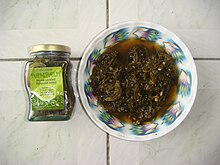Sesuvium portulacastrum
| Sesuvium portulacastrum | |
|---|---|

| |
| Scientific classification | |
| Kingdom: | Plantae |
| Clade: | Tracheophytes |
| Clade: | Angiosperms |
| Clade: | Eudicots |
| Order: | Caryophyllales |
| Family: | Aizoaceae |
| Genus: | Sesuvium |
| Species: | S. portulacastrum
|
| Binomial name | |
| Sesuvium portulacastrum | |
| Synonyms[2] | |
|
Synonymy
| |
Sesuvium portulacastrum is a sprawling perennial herb in the family Aizoaceae that grows in coastal and mangrove areas throughout much of the world.[3] It grows in sandy clay, coastal limestone and sandstone, tidal flats and salt marshes,[4] throughout much of the world. It is native to Africa, Asia, Australia, Hawai`i, North America and South America, and has naturalised in many places where it is not indigenous.[5]
It is commonly known as shoreline purslane[6] or (ambiguously) "sea purslane," in English, dampalit in Tagalog and 海马齿 hǎimǎchǐ in Chinese.
Description
[edit]Sesuvium portulacastrum is a vine up to 30 centimetres (12 in) high, with thick, smooth stems up to 1 metre (3.3 ft) long. It has smooth, fleshy, glossy green leaves that are linear or lanceolate, from 1–7 centimetres (0.39–2.76 in) long and 2–1.5 centimetres (0.79–0.59 in) wide.[7][4]
Its flowers bud from the leaf axils. They are small, 0.5 centimetres (0.20 in) in diameter and pink or purple in colour.[7][4] They close at nighttime or when the sky is cloudy. They are pollinated by bees and moths.[3]
The fruit is a round capsule, it has tiny black seeds that do not float.[3]
Taxonomy
[edit]It was first published as Portulaca portulacastrum by Carl Linnaeus in 1753.[8] Six years later Linnaeus transferred it into Sesuvium,[9] and it has remained at that name ever since, with the exception of an unsuccessful 1891 attempt by Otto Kuntze to transfer the species into a new genus as Halimus portulacastrum.[10]
Chemistry and medicine
[edit]Fatty acid composition:- palmitic acid (31.18%), oleic acid (21.15%), linolenic acid (14.18%) linoleic acid (10.63%), myristic acid (6.91%) and behenic acid (2.42%) The plant extract showed antibacterial and anticandidal activities and moderate antifungal activity.[11]
Human consumption
[edit]

Sesuvium portulacastrum is eaten in the Philippines, where it is called dampalit in Tagalog and "bilang" or "bilangbilang" in the Visayan language.[12] The plant is primarily pickled and eaten as atchara (sweet traditional pickles).
References
[edit]- ^ Bárrios, S.; Copeland, A. (2021). "Sesuvium portulacastrum". IUCN Red List of Threatened Species. 2021: e.T124232167A192137469. doi:10.2305/IUCN.UK.2021-3.RLTS.T124232167A192137469.en. Retrieved 19 December 2022.
- ^ "Sesuvium portulacastrum (L.) L." World Flora Online. World Flora Consortium. 2023. Retrieved 3 February 2023.
- ^ a b c Tan, Ria (2023). "Gelang laut (Sesuvium portulacastrum)". Wild Singapore. Retrieved 3 February 2023.
- ^ a b c "Sesuvium portulacastrum (L.) L." FloraBase. Western Australian Government Department of Biodiversity, Conservation and Attractions.
- ^ Sesuvium portulacastrum at the Germplasm Resources Information Network (GRIN)
- ^ NRCS. "Sesuvium portulacastrum". PLANTS Database. United States Department of Agriculture (USDA). Retrieved 11 November 2015.
- ^ a b Prescott, A. & Venning, J. (1984). "Aizoaceae". Flora of Australia. Vol. 4. Canberra: Australian Government Publishing Service.
- ^ "Portulaca portulacastrum L." Australian Plant Name Index (APNI), IBIS database. Centre for Plant Biodiversity Research, Australian Government.
- ^ "Sesuvium portulacastrum (L.) L." Australian Plant Name Index (APNI), IBIS database. Centre for Plant Biodiversity Research, Australian Government.
- ^ "Halimus portulacastrum (L.) Kuntze". Australian Plant Name Index (APNI), IBIS database. Centre for Plant Biodiversity Research, Australian Government.
- ^ Chandrasekaran M., Senthilkumar A., Venkatesalu V "Antibacterial and antifungal efficacy of fatty acid methyl esters from the leaves of Sesuvium portulacastrum L. ". European Review for Medical and Pharmacological Sciences. 15 (7) (pp 775-780), 2011.
- ^ Jes B. Tirol's Kapulongnan Binisaya-Ininglis/Dictionary Bisaya-English, p. 71, 2010

